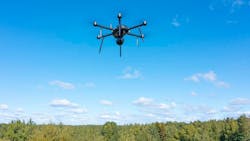Motorola Solutions, Nokia Team Up for Public Safety Drone-in-a-Box
More law enforcement agencies across the country are launching Drone as a First Responder (DFR) programs, which use drones to respond to emergencies in an effort to improve response times and increase efficiency. At the same time, many companies have been hard at work creating more advanced software and hardware to meet those needs.
This article appeared in the January/February issue of OFFICER Magazine. Click Here to subscribe to OFFICER Magazine.
In December, Motorola Solutions and Nokia announced a partnership to launch an AI-enhanced drone-in-a-box solution for public safety. Chris Bennett, Director of Product Management at Motorola Solutions, and Thomas Eder, head of Nokia’s Embedded Wireless Solutions, recently spoke to OFFICER Magazine about the new partnership and the plan to offer U.S. agencies a turnkey solution.
Joining forces
The crux of the partnership is the integration of Nokia Drone Networks with Motorola Solutions’ CAPE drone software, pairing the software platform with the Nokia Drone-in-a-Box solution, which is made in Europe and currently used by public safety agencies there. CAPE, which includes f light-safe features that adjusts the drone’s path to avoid obstacles, has a large footprint in the U.S. and was first adopted by the Chula Vista Police Department in California. The agency is a pioneer when it comes to Drone as a First Responder.
“CAPE has been a drone agnostic software platform. We believe that just gives our customers the most choice and flexibility to choose what's both at their rate price point and for their mission,” says Bennett. “But there's been an increasing demand, understandably, for a drone-in-a-box solution that could be deployed ultimately without need for that extra visual observer.” Since Nokia was strictly hardware and network focused and Motorola Solutions was focused on the software, there weren’t any competing elements between the companies.
More on OFFICER.com
Drones as First Responders: How UAVs Change Police Responses
“From our perspective, we narrowed down a lot of different pieces of hardware. We have a really high bar of performance to make sure that it's got to operate safely because we of course set the bar at being dispatched to an emergency,” he says. “There’s a pretty low tolerance for any issues. Their drone was really just a 10 out of 10 in terms of the ease of integration and the hardened communications on the drone.”
Eder, who also is division leader of a volunteer fire station in Germany, says Nokia has been in the drone space for close to a decade now, leveraging its existing technology around 4G and 5G connectivity. “We developed it over the years and hit the market with a certified solution in 2021. Currently, the country of Belgium has access to 70 Drone-in-a-Box systems. We are also doing the same thing in Switzerland with 300 systems. Now we’re going into the U.S. with selected agencies.”
Nokia was traditionally known as a cellphone company, but its new strategy is focused on connectivity. “Drones are really center stage of this new more business-to-business type of product portfolio the Nokia is generating right now,” he says. “The drones are unveiling so much potential to the things we’re already doing: intelligent networks, premium coverage in 4G, real time connectivity in 5G, efficient transmission of video codecs. There is so much more that we can bring to the drone industry and Nokia Drone Networks is a big platform for that.”
Artificial intelligence
The new solution enables public safety agencies to remotely dispatch drones from one or multiple operation centers to assess emergencies and hazards while also receiving AI-powered intelligence.
From computer-aided dispatch to body-worn cameras, AI has touched nearly every space in public safety, including drones. Bennett says what’s exciting about the intersection of AI and drones is the further development of flight routing. “I need to get my drone from point A to point B as quickly as possible. I need to go get an observation on the scene and then I need to it to return home after it finished its mission,” he says. “There could be a number of different obstacles, both visible and invisible. Your visible obstacles are your bridges, towers and buildings. But then your invisible obstacles are RF interference or maybe wind that you need to avoid. When AI has that data about the visible and invisible obstacles and your need to get from point A to point B as quickly as possible, it can more intelligently route the drone to do that than a human could because you simply cannot process all that information as well.”
Another feature of AI centers around redaction “If you think from a redaction point of view, there's already a number of privacy and transparency measures built into CAPE where the drone is not going to point down at a house when it's returning home. What about when it's capturing video of an incident of a convenience store robbery and there's a number of vehicles in the parking lot? We want to redact the license plates of the vehicles not involved in the incident. AI is great at being able to take a video like that, identify the vehicles that are not part of the incident and redact it from that video and enable the agency to get a copy of that video out to the public faster.”
The evolution of DFR
According to Bennett, CAPE has evolved along with DFR. “Particularly what we're proud of is each software release makes it more efficient to get the drone from point A to point B,” he says. “One example might be looking at different interference or network connectivity, or invisible obstacles, areas that might not get strong communications to. Now drones can take a more optimized route slightly around that interference. Whereas, in the early days of CAPE, we were more about how do we avoid the visible obstacles? How do you not bump up against a building or a bridge?”
Eder says the current environment has played a big role over the last few years in the increasing popularity of drones and the need to deploy assets remotely and quickly. “The world did not get more peaceful. The world got a little bit more difficult. The geopolitical environment we are in has not become easier.” He spoke about drone use cases surrounding events such as the COVID-19 pandemic and the war in Ukraine. “Within the last eight years, the world has changed a little bit. Also, the regulatory frameworks have developed. The FAA, the FCC. All those folks have realized that drones are becoming quite a big market. It’s always been that technology comes first and then regulation comes later. In the last 8 years, regulation has moved enough to the point where public safety agencies and selected mission-critical industries can use the drones beyond vision line of sight without bigger problems if the hardware is reliable enough.
“The transition of the drone industry from the realm of hobbyists to industry-specific applications has been really accelerated over the past few years. This has been enabled by advances in the availability of connectivity solutions that have come onto the market.”
While it was a common belief in years past that law enforcement officials would be hesitant or resistant to adopt new technology, such as drones, Bennett says that thinking has changed. “I think it’s becoming a misconception that that public safety lags behind when it comes to the adoption of technology,” he says. “In the past they haven’t been as quick to adopt it compared to healthcare or retail, but when I look at drones and even more so with AI, I’m seeing a community of practitioners that are engaging in conversations around it, reaching out to vendors, asking what they have and figuring out how to get it. That's in the community, and it is a night and day difference than it was a decade or two ago.”
About the Author
Paul Peluso
Editor
Paul Peluso is the Managing Editor of OFFICER Magazine and has been with the Officer Media Group since 2006. He began as an Associate Editor, writing and editing content for Officer.com. Previously, Paul worked as a reporter for several newspapers in the suburbs of Baltimore, MD.

